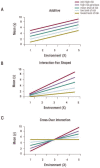The impact of gene-environment interaction on alcohol use disorders
- PMID: 23134047
- PMCID: PMC3606909
The impact of gene-environment interaction on alcohol use disorders
Abstract
This article describes three types of gene-environment interactions and the challenges inherent in interpreting these interactions. It also reports on what is known about gene-environment interactions in the field of alcohol use disorders (AUDs). Twin studies of the interaction of genetic and environmental influences on AUDs have resulted in relatively consistent findings and have suggested general mechanisms for interaction effects. These studies generally find that environments that exert more social control (e.g., higher parental monitoring, less migratory neighborhoods, etc.) tend to reduce genetic influences, whereas other environments allow greater opportunity to express genetic predispositions, such as those characterized by more deviant peers and greater alcohol availability. Conversely, the gene-environment literature that has been developed surrounding specific genes has focused largely on the role of stress as a moderator of genetic effects.
Figures

References
-
- Barr CS, Schwandt ML, Newman TK, Higley JD. The use of adolescent nonhuman primates to model human alcohol intake: Neurobiological, genetic, and psychological variables. Annals of the New York Academy of Sciences. 2004;1021:221–233. - PubMed
-
- Bau CH, Almeida S, Hutz MH. The TaqI A1 allele of the dopamine D2 receptor gene and alcoholism in Brazil: Association and interaction with stress and harm avoidance on severity prediction. American Journal of Medical Genetics. 2000;96(3):302–306. - PubMed
-
- Bjork K, Hansson AC, Sommer WH. Genetic variation and brain gene expression in rodent models of alcoholism. Implications for medication development. International Review of Neurobiology. 2010;91:129–171. - PubMed
-
- Blomeyer D, Treutlein J, Esser G, et al. Interaction between CRHR1 gene and stressful life events predicts adolescent heavy alcohol use. Biological Psychiatry. 2008;63(2):146–151. - PubMed

